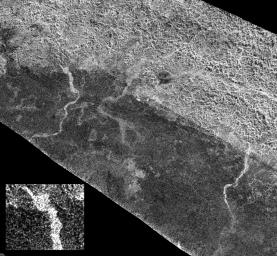
|
Xanadu’s Channels
- Click the image above for a larger view
- Full-Res JPEG (1060 x 979) (375.5 kB)
- Full-Res TIFF (1060 x 979) (1.0 MB)
Caption:
On the final flyby of Cassini's original four-year tour, its radar mapper captured these unusual channels on Titan at the edge of Xanadu, the widest seen in this area (For a radar image of Xanadu see PIA08428 ). These might be active rivers carrying methane or debris, or they might be dry riverbeds similar to earthly arroyos.
Past Cassini radar images have revealed different types of channels on Titan's surface (see PIA03565 and PIA07366 ). They vary from bright to dark in radar (rough to smooth), and from fan-shaped to braided to meandering. Some drain into lakes, others disappear. Some of these channels may be several hundred meters, or feet, deep.
This image, taken from the flyby on May 28, 2008, shows the border of Xanadu as the bright-dark boundary running from the upper left to lower right. Southward from that boundary is an unusual set of channels. While these are brighter (more roughly textured) than the surrounding terrain, some are only slightly brighter, and some are as wide as 5 kilometers (about 3 miles)—about the size of the River Thames at its mouth east of London. They appear to flow out of the rough region of Xanadu. Careful inspection reveals smaller tributaries that wind through the brighter and apparently rougher terrain to the north. A close-up of one of the widest channels is shown at the lower left.
Scientists think that many of the channels on Titan are carved by methane deposited on the surface from strong but infrequent rainstorms. A bright channel may be dry, with the rough riverbed of icy particles (like those seen at the Huygens landing site) producing the radar brightness. The darker channels in this image resemble the dry lakes seen in the north polar area of Titan, so they may be dry as well, with their smoother (radar-dark) surfaces caused by finer-grained sediment deposits on the channel floors.
This image shows an area located at 15 degrees south latitude and 121 degrees west longitude. It is about 450 kilometers (280 miles) across, and has approximately 1 kilometer (0.62-mile) resolution. North is up.
Background Info:
The Cassini-Huygens mission is a cooperative project of NASA, the European Space Agency and the Italian Space Agency. NASA's Jet Propulsion Laboratory, a division of the California Institute of Technology in Pasadena, manages the mission for NASA's Science Mission Directorate, Washington, D.C. The Cassini orbiter was designed, developed and assembled at JPL. The radar instrument was built by JPL and the Italian Space Agency, working with team members from the United States and several European countries.
For more information about the Cassini-Huygens mission visit http://saturn.jpl.nasa.gov/ .
Cataloging Keywords:
| Name | Value | Additional Values |
|---|---|---|
| Target | Titan | |
| System | Saturn | |
| Target Type | Satellite | |
| Mission | Cassini-Huygens | |
| Instrument Host | Cassini Orbiter | Huygens Probe |
| Host Type | Orbiter | Lander, Probe |
| Instrument | Radar Mapper | |
| Detector | ||
| Extra Keywords | Atmosphere, Grayscale, Methane, Radar, Storm | |
| Acquisition Date | ||
| Release Date | 2008-08-08 | |
| Date in Caption | 2008-05-28 | |
| Image Credit | NASA/JPL-Caltech/ASI | |
| Source | photojournal.jpl.nasa.gov/catalog/PIA10956 | |
| Identifier | PIA10956 | |
